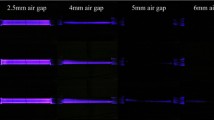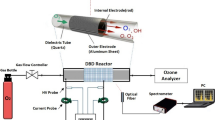Abstract
This paper features the pulse polarity effect on ozone generation efficiency by adjusting the applied voltage and the flow rate in a coaxial dielectric barrier discharge reactor. Results show that utilization of unipolar pulse has better performance when compared with the bipolar mode, but on the other hand, utilization of the positive pulse has slightly higher efficiency than that of negative mode. Meanwhile, changing the gas flow rate shows a minor effect on ozone generation. Utilization of bipolar pulse would decrease the breakdown voltage and ozone generation efficiency when compared with unipolar pulse while it would lead to higher ozone concentrations at fixed applied voltage. The maximum ozone yield reaches 186.9 g/kWh at 6 kV positive pulse with ozone concentration of 11.9 g/Nm3.







Similar content being viewed by others
References
Kogelschatz U, Eliasson B, Hirth M (1988) Ozone generation from oxygen and air: discharge physics and reaction mechanisms. Ozone Sci Eng 10(4):367–377
Sung T-L, Teii S, Liu C-M, Hsiao R-C, Chen P-C, Wu Y-H et al (2013) Effect of pulse power characteristics and gas flow rate on ozone production in a cylindrical dielectric barrier discharge ozonizer. Vacuum 90:65–69
Huang G, Zhou Y, Wang T, Timoshkin IV, Wilson MP, MacGregor SJ et al (2016) Statistical analysis of pulsed microdischarges and ozone generation in dielectric barrier discharges. IEEE Trans Plasma Sci 44:2111–2120
Wang D, Namihira T, Akiyama H (2009) Pulsed discharge plasma generated by nano-seconds pulsed power in atmospheric air. In: Pulsed power conference. IEEE, pp 1046–1049
Morimoto M, Ninomiya T, Ikemoto T, Teranishi K, Shimomura N (2016) Ozone production by streamer discharges using nanosecond pulsed powers and coaxial reactor with tensioned inner electrode. IEEE Trans Plasma Sci 44:2190–2195
Yuan D, Wang Z, Ding C, He Y, Whiddon R, Cen K (2016) Ozone production in parallel multichannel dielectric barrier discharge from oxygen and air: the influence of gas pressure. J Phys D Appl Phys 49(45):455203
Wei LS, Yuan DK, Zhang YF, Hu ZJ, Dong GP (2014) Experimental and theoretical study of ozone generation in pulsed positive dielectric barrier discharge. Vacuum 104:61–64
Samaranayake WJM, Miyahara Y, Namihira T, Katsuki S, Hackam R, Akiyama H (2001) Ozone generation in dry air using pulsed discharges with and without a solid dielectric layer. IEEE Trans Dielectr Electr Insul 8(4):687–697
Wei LS, Peng BF, Li M, Zhang YF (2016) A numerical study of species and electric field distributions in pulsed DBD in oxygen for ozone generation. Vacuum 125:123–132
Malik MA, Schoenbach KH, Abdel-Fattah TM, Heller R, Jiang C (2017) Low cost compact nanosecond pulsed plasma system for environmental and biomedical applications. Plasma Chem Plasma Process 37(1):59–76
Takamura N, Matsumoto T, Wang D, Namihira T, Akiyama H (2011) Ozone generation using positive-and negative-nano-seconds pulsed discharges. In: Pulsed power conference. IEEE, pp 1300–1303
Malik MA, Schoenbach KH (2014) Nitric oxide conversion and ozone synthesis in a shielded sliding discharge reactor with positive and negative streamers. Plasma Chem Plasma Process 34(1):93–109
Malik MA (2014) Ozone synthesis using shielded sliding discharge: effect of oxygen content and positive versus negative streamer mode. Ind Eng Chem Res 53(31):12305–12311
Malik MA, Schoenbach KH, Heller R (2014) Coupled surface dielectric barrier discharge reactor-ozone synthesis and nitric oxide conversion from air. Chem Eng J 256:222–229
Šimek M, Pekárek S, Prukner V (2010) influence of power modulation on ozone production using an AC surface dielectric barrier discharge in oxygen. Plasma Chem Plasma Process 30(5):607–617
Eliasson B, Hirth M, Kogelschatz U (1987) Ozone synthesis from oxygen in dielectric barrier discharges. J Phys D Appl Phys 20(11):1421
Liu S (2003) Electrical modeling and unipolar pulsed energization of dielectric barrier discharges. Tenea Verlag Ltd., Berlin
Acknowledgements
This research was supported by the National Natural Science Foundation of China (Grant Nos. 51422605, 51366012) and the Zhejiang Provincial Natural Science Foundation (LR16E060001).
Author information
Authors and Affiliations
Corresponding author
Rights and permissions
About this article
Cite this article
Yuan, D., Ding, C., He, Y. et al. Characteristics of Dielectric Barrier Discharge Ozone Synthesis for Different Pulse Modes. Plasma Chem Plasma Process 37, 1165–1173 (2017). https://doi.org/10.1007/s11090-017-9793-y
Received:
Accepted:
Published:
Issue Date:
DOI: https://doi.org/10.1007/s11090-017-9793-y




